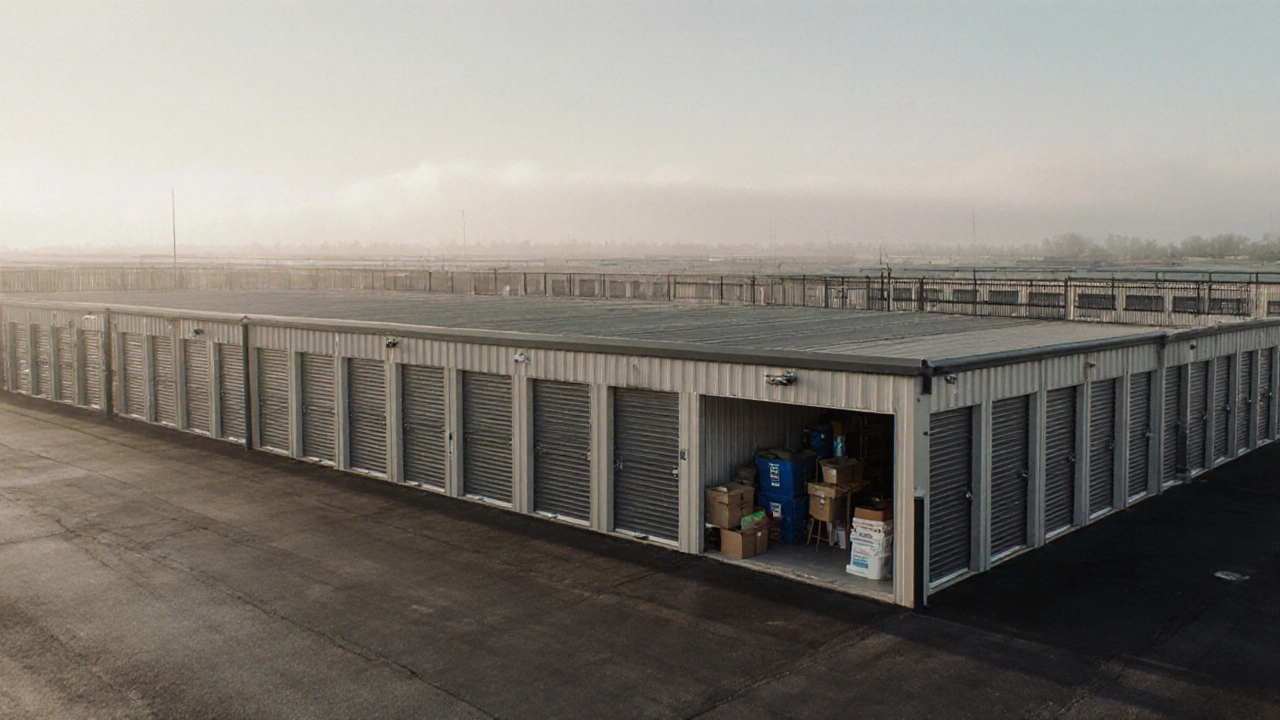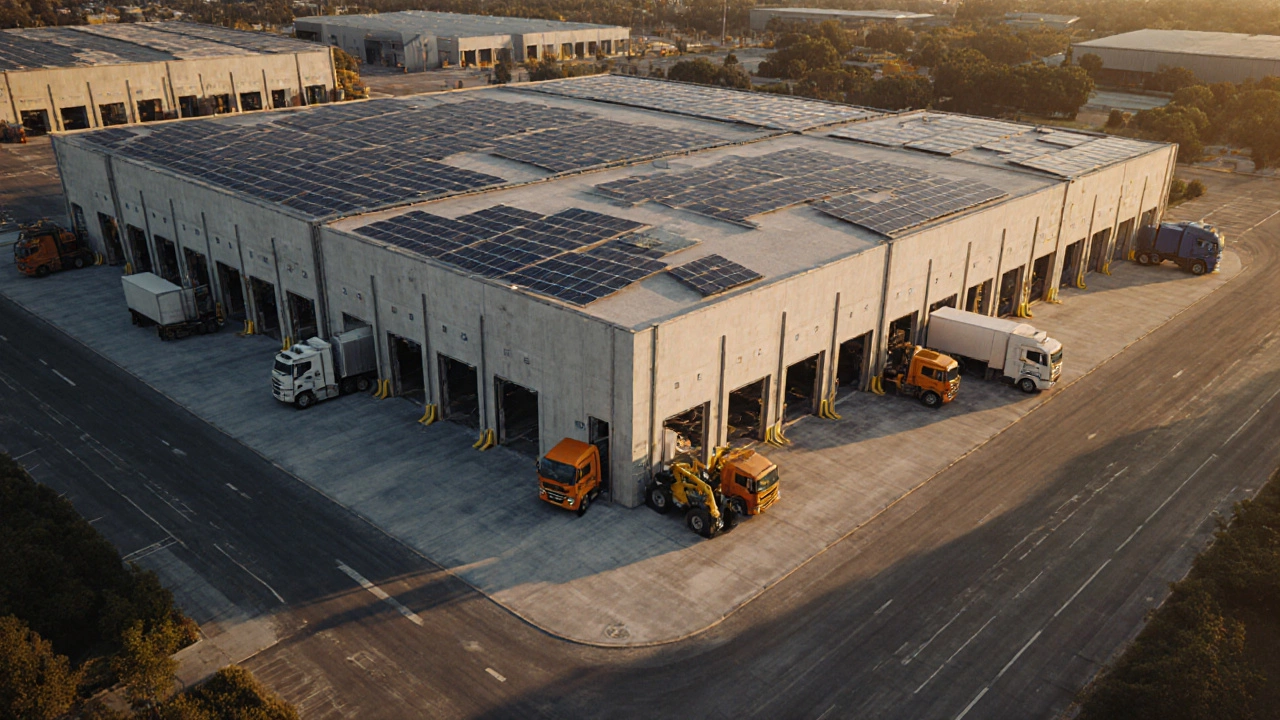Commercial Property ROI Calculator
Enter property details to see estimated returns
Important Note: These calculations are based on current market data from the article. Actual returns may vary based on location, lease terms, and market conditions.
When you’re looking to invest in commercial property, the big question isn’t just what to buy-it’s which one actually puts the most money in your pocket. Not all commercial properties are created equal. A strip mall might look safe, but it could be sitting on a sinking foundation of empty storefronts. A warehouse on the edge of town might seem dull, but it’s quietly generating rent from Amazon delivery hubs and local distributors. The most profitable commercial property in 2025 isn’t the flashiest-it’s the one that meets real, growing demand.
Industrial Warehouses Are Leading the Pack
Forget fancy office towers with rooftop gardens. The real money right now is in industrial space-think warehouses, distribution centers, and light manufacturing facilities. In Melbourne, vacancy rates for modern industrial buildings dropped to 2.1% in Q3 2025, the lowest in a decade. Why? E-commerce isn’t slowing down. Every online order needs a place to be packed, stored, and shipped. Companies like DHL, Kogan, and even local grocery delivery services are signing 10-year leases for spaces between 5,000 and 50,000 square feet.
These properties often come with high ceilings, loading docks, and strong power supply-all things you can’t easily add later. That makes them scarce. Landlords can charge $25-$40 per square meter annually, with triple-net leases meaning tenants pay property taxes, insurance, and maintenance. That’s a net return of 6-8% before appreciation. In some pockets like Narre Warren or Dandenong South, prices have jumped over 18% in the last two years.
Medical and Healthcare Facilities Are Stable and Growing
People don’t stop needing doctors, physios, or dentists during a recession. That’s why medical office buildings are one of the safest bets. In Australia, the aging population means demand for private clinics, diagnostic centers, and allied health services is rising fast. A single-story medical suite in suburbs like Box Hill or Frankston can rent for $35-$50 per square meter annually. Tenants are usually professional practices with long-term leases-often 5-7 years-with built-in rent increases.
These properties don’t appreciate as fast as warehouses, but they rarely sit empty. A doctor’s practice doesn’t move because the rent went up $200 a month. They stay. And because these tenants need specific layouts-exam rooms, sterilization areas, waiting zones-they can’t easily relocate. That gives landlords strong bargaining power.
Self-Storage Units Are Quietly Explosive
Here’s something you might not think of: self-storage. It’s not glamorous, but it’s simple, scalable, and surprisingly profitable. In Melbourne, demand for storage units has grown 12% annually since 2020. Why? People are moving more. They’re downsizing. They’re holding onto furniture during renovations. They’re storing holiday decorations, bikes, or business inventory.
A single-level self-storage facility with 100 units can cost $2-$3 million to build, but it can generate $250-$400 per unit per month in rent. That’s $300,000 to $480,000 in annual income. Operating costs are low-mostly security, insurance, and cleaning. No plumbing, no HVAC systems, no maintenance headaches. ROI? Often 8-12% in the first five years. And because these units are small and modular, you can start with 50 units and expand later.

Retail Spaces Are Riskier Than Ever
Don’t be fooled by the shiny new shopping centers. The retail landscape has changed. Big-box stores like Kmart and Target are shrinking. Foot traffic is down. Online shopping eats up 18% of all retail sales in Australia-and that number keeps climbing. Even if you find a tenant, they’re negotiating harder. Rent concessions are common. Fit-out allowances? Often required.
A corner shop in a suburban strip mall might rent for $20-$30 per square meter, but you’ll likely face 3-6 months of vacancy between tenants. And when you do get one, they might ask you to pay for new signage, flooring, or even a kitchen hood. The risk-reward ratio isn’t great anymore. Unless you’re buying a prime location in a high-income area like Toorak or Brighton, retail is not the best play right now.
Office Space? Only If It’s Modern and Flexible
Office space isn’t dead-but it’s been reshaped. The old model of 100-person corporate leases is gone. Now, the winners are flexible, tech-ready spaces with good natural light, outdoor areas, and proximity to public transport. Think co-working hubs, hybrid-friendly offices, or buildings with strong ESG ratings (energy efficiency, sustainability).
Class A office buildings in Melbourne’s CBD still command $60-$80 per square meter annually. But Class B and C? Vacancy rates are over 15%. If you’re buying office space, you need to ask: Is it LEED-certified? Does it have EV charging? Can tenants break the lease after 18 months? If the answer is no, you’re taking on way more risk than reward.
What About Mixed-Use Buildings?
Mixed-use-retail on the ground floor, offices or apartments above-is still popular, but only in the right locations. In areas like Fitzroy, Collingwood, or Footscray, you’ll find strong demand. People want to live above a café or walk to a pharmacy. But in less walkable suburbs, these buildings sit half-empty. The key is location density. If the area doesn’t have at least 5,000 residents within a 1km radius, don’t bother.
These properties offer diversification: rent from retail, rent from residential. But they’re harder to finance, harder to manage, and harder to sell. You need a specialist buyer’s agent and a clear plan for tenant mix. For beginners, it’s not the easiest path.

The Bottom Line: Where to Put Your Money
Let’s cut through the noise. In 2025, the most profitable commercial property types are:
- Industrial warehouses - Highest demand, lowest vacancy, best returns.
- Self-storage facilities - Low maintenance, high margins, easy to scale.
- Medical office buildings - Stable tenants, long leases, recession-resistant.
These three types consistently outperform retail, traditional offices, and even mixed-use in net yield and occupancy rates. They’re not sexy. But they’re reliable. And in commercial real estate, reliability beats flash every time.
What to Avoid
Stay away from:
- Old retail strips with no foot traffic
- Class B or C office buildings without upgrades
- Properties without access to major roads or public transport
- Buildings that require major structural changes (like converting a warehouse to offices)
These are money pits. You’ll spend more on renovations than you earn in rent. And when you try to sell, buyers will walk away.
Final Tip: Location Still Matters-But Not the Way You Think
You don’t need to buy in the CBD to win. In fact, the best deals are often on the outskirts. Look for areas with:
- Proximity to major freight routes (M1, M8, West Gate Freeway)
- Access to rail or bus lines
- Population growth (like Casey, Melton, or Wyndham)
- Local government infrastructure plans (new roads, utilities, schools)
These are the places where demand is building. That’s where your property will appreciate fastest.
Is industrial property really more profitable than retail?
Yes, in 2025. Industrial properties have vacancy rates under 3% in Melbourne, while retail vacancy rates hover around 10-15%. Industrial tenants pay higher rent per square meter and cover their own taxes and maintenance. Retail tenants often demand rent holidays, fit-out contributions, and shorter leases. The math favors industrial.
Can I invest in commercial property with less than $500,000?
Yes, but your options shrink. You can buy a small self-storage unit (as little as 10-15 units) or a single medical office suite under $500k in outer suburbs. Industrial units this size are rare and usually require $800k+. Look for joint ventures or REITs if you’re under $500k. Don’t stretch your budget-you need cash reserves for vacancies and repairs.
What’s the average return on commercial property in Melbourne?
Returns vary by type. Industrial: 6-8%. Self-storage: 8-12%. Medical offices: 5-7%. Retail: 4-6% (and often lower after tenant incentives). Office: 5-7% for Class A, but 3-4% for older buildings. Always calculate net yield after all expenses, not just rent.
Do I need a special license to own commercial property?
No, you don’t need a license to own commercial property in Australia. But you do need to comply with zoning laws, building codes, and tenancy agreements. Some uses-like self-storage or medical clinics-require council permits for operation. Always check with your local council before buying.
Should I buy a property with existing tenants?
Absolutely-if the lease is strong. Existing tenants mean immediate cash flow and lower risk. Look for leases with 3+ years remaining, rent reviews every 3-5 years, and tenants with good credit. Avoid tenants with short leases or those in struggling industries (like print shops or video rental stores).
